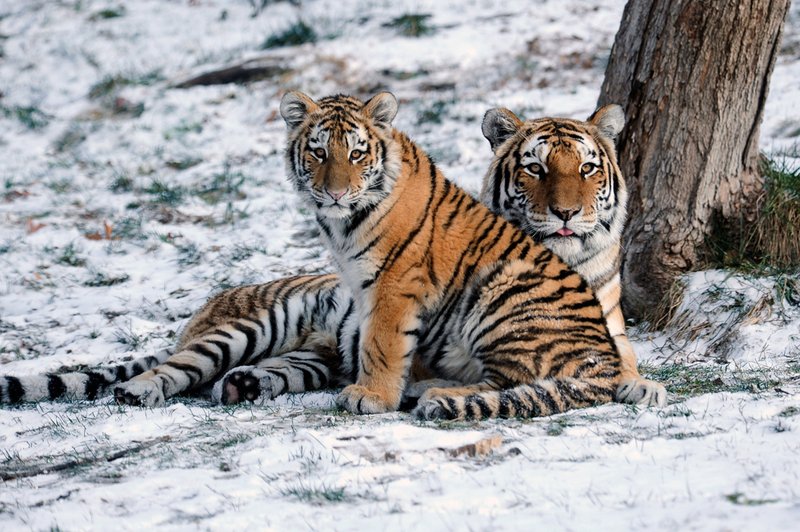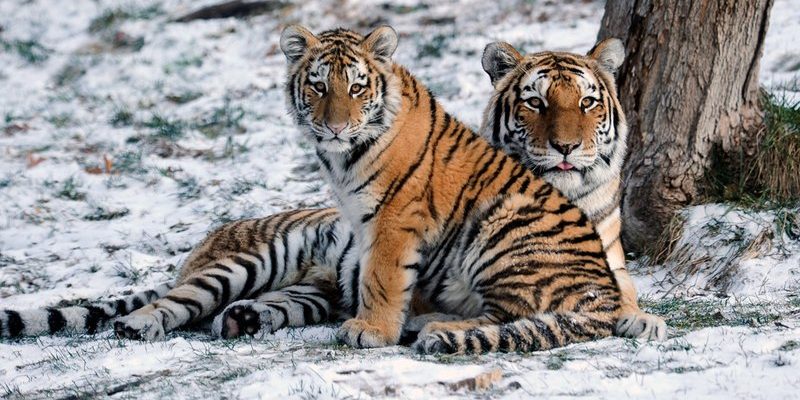
Imagine being a single parent in the wilderness. That’s basically what these tiger moms experience! They have to hunt for food while keeping their cubs safe from other predators. The survival of their young depends on their skills and instincts. So, let’s dive into how these majestic creatures raise their cubs, ensuring they grow up strong and ready to rule the wild one day.
Finding the Perfect Den
When it’s time to have cubs, a female Siberian tiger searches for a safe and cozy den. This is usually a hidden spot in a rocky crevice, a hollow log, or even a dense thicket. It’s crucial for keeping the cubs out of sight of potential threats. Just like how we might look for a safe place to stay when we’re camping, these tigers choose their dens carefully.
Once the mother finds a suitable location, she prepares it for the arrival of her cubs. She’ll clear away debris and make it as comfortable as possible. The den acts as a sanctuary where the cubs will be born and will spend their early days. This is a critical time, as newborn tigers are pretty vulnerable.
Did you know that a tiger’s den can sometimes be reused? If the mother has another litter in the future, she may choose the same spot again, ensuring it’s a familiar place for her cubs.
Giving Birth and Early Care
When the time comes to give birth, the mother tiger typically has between one to four cubs. These little ones are blind and helpless at first, weighing around two to three pounds. Here’s the thing: a mother’s job is just beginning. She has to care for them closely, feeding them with her milk and keeping them warm.
In the first few weeks of life, the cubs depend entirely on their mother. She stays close, constantly watching over them. If she feels threatened, she’ll move them to a different location to keep them safe. Imagine a mother protecting her children in a busy city—she’s always on high alert.
The early care is vital for the cubs. They grow quickly during this stage, and the mother’s milk provides them with the essential nutrients they need. During this time, you might see her gently licking them to help them stay clean and stimulate their growth. It’s a beautiful bond that forms right from the start.
Teaching Survival Skills
As the cubs grow, usually around three months old, their mother begins to teach them important survival skills. This is like sending kids to school, where they learn the ropes of life. The mother takes them out of the den, introducing them to their surroundings and showing them how to navigate their habitat.
She starts with basic skills like hunting techniques and understanding how to stalk prey. You might see her demonstrating how to move quietly or to hide behind bushes when approaching animals. This is a crucial time for the cubs, as learning these skills will help them survive once they’re on their own.
The mother also emphasizes the importance of social behavior. The cubs play together, practicing their pouncing and wrestling skills, which is vital for their development. Social play helps them build confidence and learn to work as a team.
Feeding and Growing Up
Hunting isn’t just about catching food; it’s a full-on lesson for the young tigers. As each cub approaches the age of six months, the mother starts bringing back food for her young. She might catch a deer or a wild boar, and then she’ll encourage her cubs to eat solid food.
At first, she brings the food back to the den, where the cubs can get their first taste of meat. You can imagine how excited they must be to sink their teeth into something other than milk! Over time, she begins taking them along on her hunts, allowing them to witness the entire process.
This hands-on experience is invaluable. It not only teaches them hunting techniques but also instills a sense of independence. They learn the importance of patience, stealth, and teamwork while snacking on their tasty prizes.
Growing Independence
As the cubs near the age of two years, they start becoming more independent. They’re no longer just relying on their mother for everything. This is when the real world starts to open up for them. The mother begins to teach them about marking territory and recognizing scents, a vital skill for any tiger.
During this time, you might see the cubs venturing further away from the den. They’ll explore the surrounding areas, practicing their hunting skills and gaining confidence. It’s quite an exciting period where they learn their boundaries and how to interact with other wildlife.
Though the mother is still present, she’s now allowing them to make their own decisions. This is akin to teenagers learning to navigate life independently. The bonding hasn’t stopped, but it’s evolving, preparing the cubs for when they’ll eventually leave to start their own families.
Leaving the Nest
Eventually, the time comes for the cubs to venture out on their own. This typically happens around the age of two to three years. The mother tiger has given them all the tools they need to survive in the wild, and now they need to make their way independently. It’s a bittersweet moment, much like when a parent sends their child off to college.
Before they leave, the mother might teach them how to establish their own territories. She’ll guide them on how to avoid conflicts with other tigers and how to find food sources. Each cub may take a slightly different path as they branch out into the vast wilderness, but they carry with them the lessons their mother embedded in them.
Even after leaving, there’s often a silent connection. They may return to visit their mother, especially if they find themselves in a tricky situation. The bond remains strong, even as they establish their lives in the wild.
The Importance of Family Bonds
Family is everything for Siberian tigers. The strong bond between a mother and her cubs shapes their lives and futures. It’s not just about survival; it’s about passing on essential skills and knowledge. Tigers are solitary by nature, but the early years are all about teamwork and togetherness.
When you think about how Siberian tigers raise their young, it’s clear that there’s a lot of love and effort involved. The mother tiger ensures her cubs are well-equipped to take on the challenges of life in the wild. Every hunt, every lesson, and every moment spent together plays a role in shaping the future of these magnificent creatures.
Emphasizing this nurturing side of Siberian tigers gives us a deeper appreciation for their role in the ecosystem. It’s a reminder that every creature, no matter how fierce, has a softer side, and family bonds are what hold them together.
In the wild, raising young is not just about survival; it’s a journey filled with lessons, love, and the hope of a thriving future. That’s how Siberian tigers raise their young, and it’s truly fascinating!

